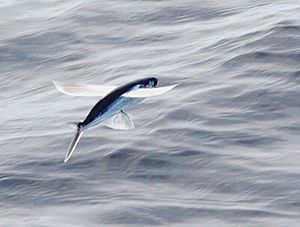Atlantic flyingfish facts for kids
Quick facts for kids Atlantic flyingfish |
|
|---|---|
 |
|
| In flight | |
| Conservation status | |
| Scientific classification | |
| Synonyms | |
|
The Atlantic flyingfish (Cheilopogon melanurus) is an amazing fish known for its ability to glide above the water! It is part of the flying fish family, called Exocoetidae. A French scientist named Achille Valenciennes first described this fish in 1847. He wrote about it in a large book called Natural History of Fish, which he created with another scientist, Georges Cuvier.
How They Fly
The Atlantic flyingfish has a body shaped like a cylinder. It also has large tail and pectoral fins. These fins are like wings that help it fly. To "fly," the fish first jumps out of the water. Then, it uses its big pectoral fins to catch air currents. This helps it get lift and stay in the air. It also beats its tail very fast to push itself forward.
This fish can grow up to 32 centimeters (about 12.5 inches) long. However, most adult flyingfish are around 25 centimeters (about 10 inches) long. Their top side is usually green or blue. Their belly side is white or silver.
After reaching a speed of about 30 kilometers per hour (18.6 mph), these fish can jump out of the water. They can then glide for about 3 to 12 meters (10 to 40 feet). They do this mainly to escape from bigger fish that want to eat them.
Where They Live
As its name suggests, the Atlantic flyingfish lives in the Atlantic Ocean. You can find them in both the open ocean and closer to shore.
In the western Atlantic, they live in warm waters like the Gulf Stream. This area stretches from Massachusetts all the way south to Brazil. They are also found in the Caribbean Sea and around the Antilles islands. Further north, they can be seen off the coast of Canada.
Near Africa, Atlantic flyingfish are found from Senegal to Liberia. They have also been seen near São Tomé and Príncipe. They usually swim near the surface of the water, close to the coast. Here, they are hunted by larger fish and seabirds, such as the Wahoo and the Sooty tern.
Young Atlantic flyingfish, up to 15 centimeters (6 inches) long, have clear pectoral fins. These younger fish often swim in harbors or bays.
Gallery
-
A beached Atlantic flyingfish found in Fort Pierce, Florida.





